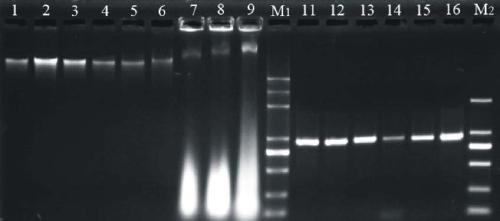Kit and method for extracting pectin-rich polysaccharide plant DNA
A kind of polysaccharide and kit technology, applied in the field of genetic engineering, can solve the problems of difficult to obtain high-quality and high-quantity genomic DNA, inability to obtain DNA, and low DNA quantity, so as to improve DNA quality and yield and avoid secondary quality browning high-quality, high-quality
- Summary
- Abstract
- Description
- Claims
- Application Information
AI Technical Summary
Problems solved by technology
Method used
Image
Examples
Embodiment 1
[0056] Okra is one of the plants known to contain particularly high levels of pectin polysaccharides and polyphenols. Due to the combination of traditional buffers and viscous polysaccharides, it is easy to form insoluble jelly, which interferes with the extraction and purification of DNA. The present invention aims at this problem, improves the extraction method in combination with the kit described in the present invention, and successfully extracts high-quality okra genomic DNA. Specific steps are as follows:
[0057] (1) Take about 0.2 g of fresh young okra leaves in a mortar, add liquid nitrogen to grind them into fine powder, and quickly collect them into a 2.0 mL centrifuge tube.
[0058] (2) Add 1.5 mL of 4°C pre-cooled desugar buffer and 15 μL of β-mercaptoethanol to the centrifuge tube, mix well, and place in a 4°C refrigerator for 10 min, during which time, invert and mix once. Centrifuge at 9000 rpm for 8 min, discard the supernatant, and collect the precipitate. ...
Embodiment 2
[0069] Citrus, aloe vera, dendrobium, fig, and grape are plants containing pectin polysaccharides or other secondary metabolites that are particularly high. Using the method of the present invention to extract genomic DNA, the steps are as follows:
[0070] (1) Sample processing:
[0071] a. Citrus, figs, grapes: take the young leaves, add liquid nitrogen to grind them for later use;
[0072] b. Aloe vera: After removing the thorns, add liquid nitrogen to grind for later use;
[0073] c. Dendrobium: take the stem, add liquid nitrogen and grind for later use;
[0074] Take 0.2 g of the above-mentioned plant samples of a-c respectively, and put them into 2.0 mL centrifuge tubes for later use.
[0075] The rest of the steps were carried out in sequence with (2)-(11) in Example 1, and each plant DNA sample was collected.
PUM
 Login to View More
Login to View More Abstract
Description
Claims
Application Information
 Login to View More
Login to View More - R&D
- Intellectual Property
- Life Sciences
- Materials
- Tech Scout
- Unparalleled Data Quality
- Higher Quality Content
- 60% Fewer Hallucinations
Browse by: Latest US Patents, China's latest patents, Technical Efficacy Thesaurus, Application Domain, Technology Topic, Popular Technical Reports.
© 2025 PatSnap. All rights reserved.Legal|Privacy policy|Modern Slavery Act Transparency Statement|Sitemap|About US| Contact US: help@patsnap.com

